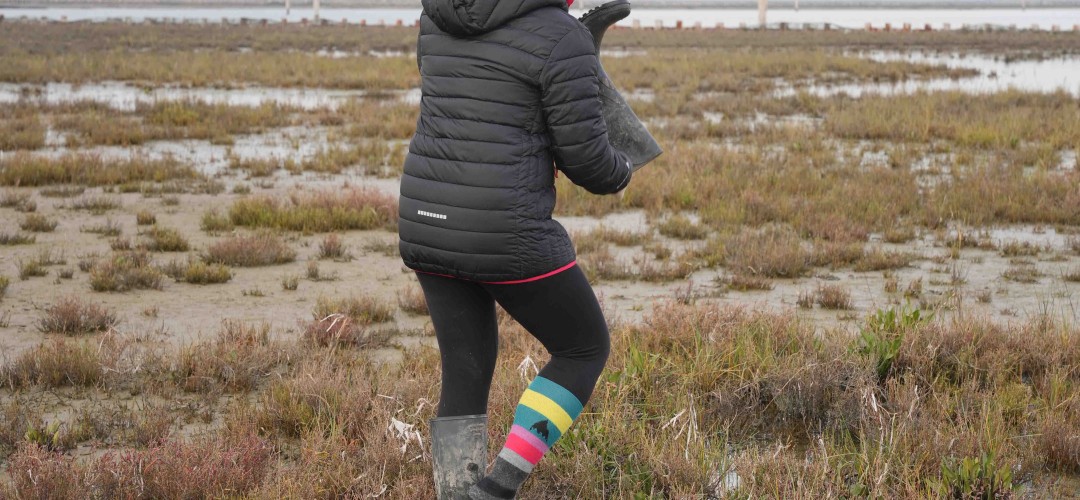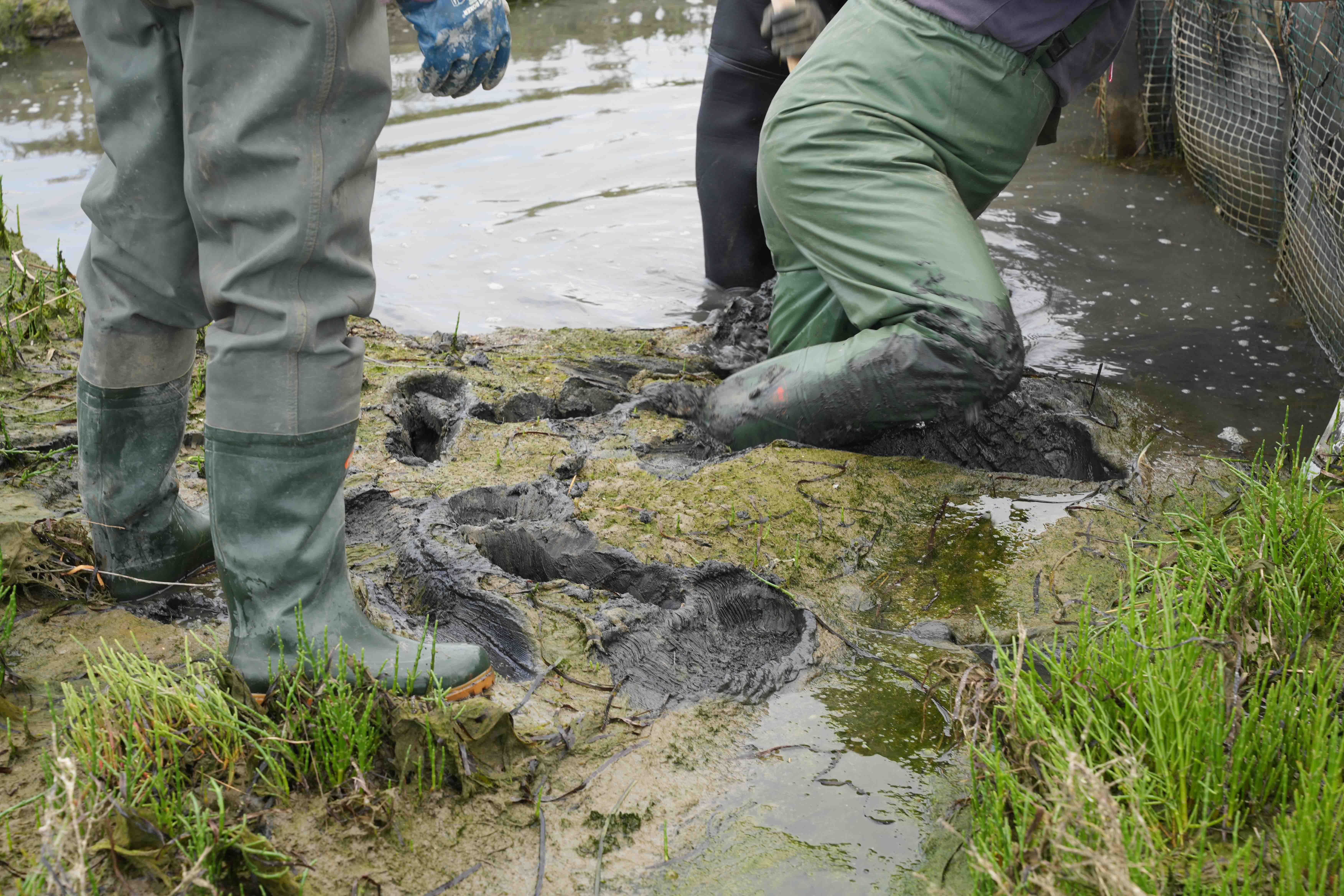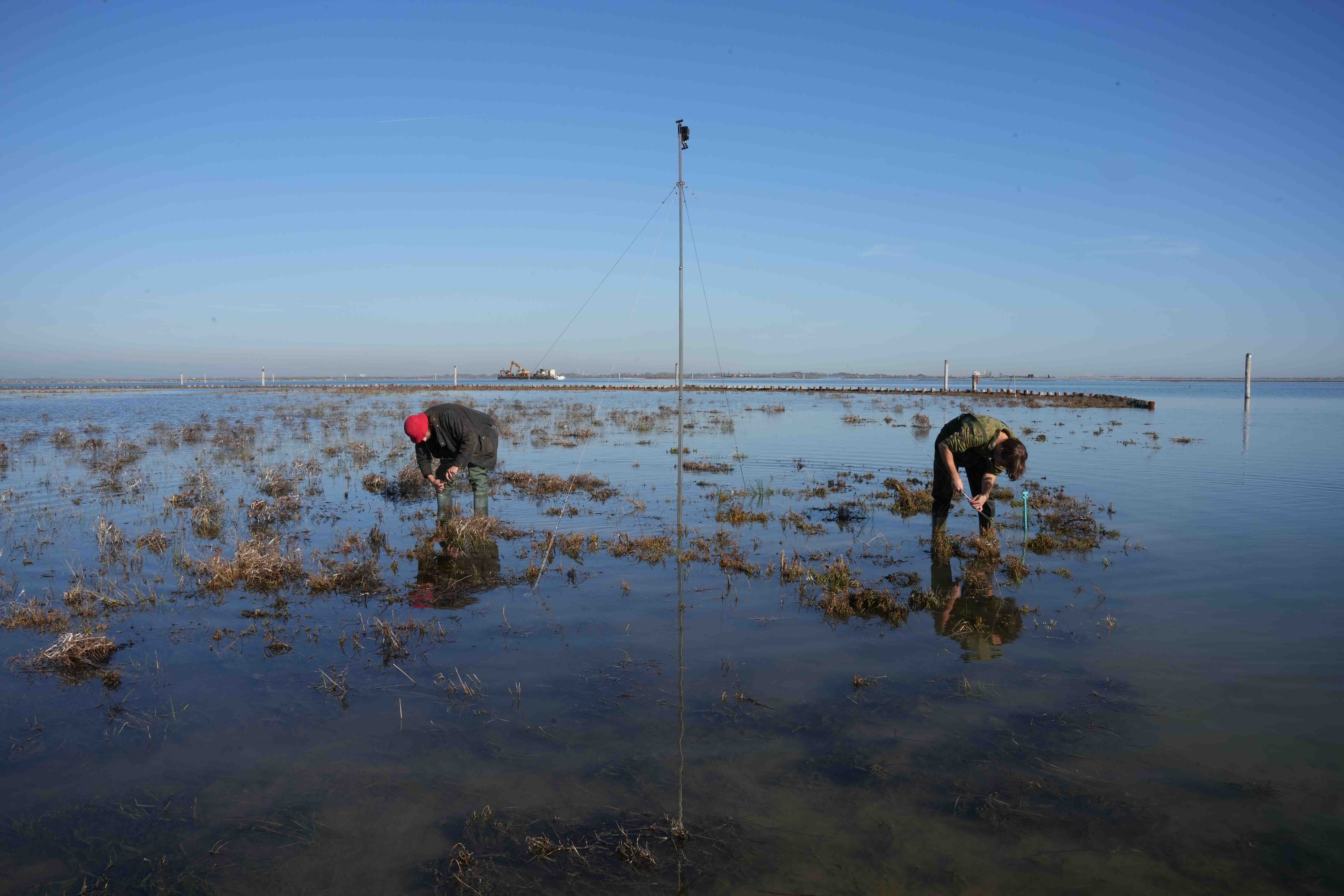Getting Our Feet Wet
Getting Our Feet Wet

We are here Venice è stato invitato a contribuire alla pubblicazione Architecture of Stewardship, realizzata in occasione del Padiglione della Finlandia alla Biennale Architettura 2025. Il saggio Getting Our Feet Wet, è firmato da Margherita Scapin e Carolyn Smith, collaboratrici di WahV e ricercatrici interdisciplinari attive nell’iniziativa Vital sin dalla sua fondazione nel 2020. Il testo propone il ripristino ecologico come una forma radicale e necessaria di manutenzione a lungo termine — una pratica di cura essenziale per la resilienza di Venezia. Nato da un primo incontro nella laguna, dove il sale risale i muri e il fango trattiene la memoria, il saggio riflette su acqua, sedimenti e barene come forze dinamiche di degrado e rigenerazione. Questa prospettiva si allinea al tema centrale del Padiglione: l’architettura come processo collettivo e continuo, che include anche i sistemi viventi da cui il costruito dipende — facendo di Venezia un luogo di intelligenza condivisa.
Segue il saggio originale in inglese, pubblicato per la prima volta in Ella Kaira & Matti Jänkälä (a cura di), Architecture of Stewardship, Arvinius + Orfeus & Archinfo 2025. Il Team di Vital è lieto di rendere accessibile questo contributo nella sua lingua originale, offrendo uno sguardo sulle motivazioni radicali che guidano il ripristino ecologico e un esempio di come temi fondamentali per Venezia possano trovare spazio nell’ambito della Biennale.
Getting Our Feet Wet
Venice is a city defined by its relationship with water. While the principles of architecture are largely determined by a building’s ability to shed humidity, the stones of Venice (to paraphrase John Ruskin) defy architectural common-sense and stand firmly planted within the largest coastal wetland in the Mediterranean. Covering an area of 550 square metres, the Venetian Lagoon is a complex environment, comprised of inhabited islands, salt- marsh habitats, mudflats, and the brackish waters, which are all subject to the ebb and flow of the tides.
The interwoven tapestry of the wetland (not quite land, not quite water) is more-than-human yet less-than-natu- ral (only partially the result of human choices). It challenges modernist categories and cartographies that seek to define and distinguish where one thing ends and another begins. Venice has always blurred the boundaries between human and non- human agency — the city is not just built within a lagoon, Venezia è laguna: Venice is the Lagoon.
This peculiar physical and conceptual position defies anthropogenic notions of humanity’s dominance over nature, instead painting a picture of care-full cohabitation and innovation spanning millennia. Many architects and engineers would be forgiven for predicting that building a city in mud would be ‘dead in the water’, yet with ingenuity, experimentation, and thousands of wooden piles driven into the mud, Venice rose from the murky marshland — and prospered.
Venice’s isolation within the Lagoon is the cornerstone upon which its myths were founded and the source of the city’s peculiarities. The result was a unique socio-political dynamic which emphasised co-operative work, accepted centralised planning restrictions, valued cultural porosity, and honoured an extraordinary aesthetic culture inspired by life within the ‘physical kaleidoscope’ of shifting reflections, refractions, and sensory experiences on the watery plains[1]. But the pragmatic drive for survival, powered by innovation, has always been at the core of its culture. It was this drive which propelled the tenuous timber settlements of the fifth century to become one of the most famous and influential cities in the world.
If Venice seems at first glance a museum, what it places on display is the continuous work of tempo — which can be translated as both ‘time’ and ‘weather’ — on the precarious reality of all human construction [2].
Despite the theatricality of the Venetian ‘brand’, the logic of the city is defined by a pragmatic approach to the necessary compromises of living-with the Lagoon. While Venice is often seen to be ‘timeless’ by visitors, this misconception obscures the real lessons that can be learned from the city: the constant yet careful maintenance that replaces brickwork damaged by the salt water; the large infrastructural works of the 1990s and early 2000s that raised pavement levels throughout the city to accommodate rising sea levels and reduce exposure to flooding; even the passerelle-lined walkways which allow residents to continue their daily routines via regularly submerged streets during recurrent acqua alta [high tides]. Venice is a city in process, rather than product for consumption. These processes are responsive to changing weather (literal and metaphorical) and, as such, the city is evidence of centuries of evolution in response to environmental change with increasing contemporary relevance during the so-called Anthropocene.
The Venetian case illustrates the importance of response- able action that honours the dynamics of the Lagoon and the city’s rich past, without undermining its present and compromising its future. The Venetian idiom un palo fa palùo [a pole makes a mudflat] references the consciousness during the city’s Republican era that every human action (such as planting a pole) has a consequence; each incremental action has a legacy. The Lagoon has been subject to human intervention for more than a thousand years; the Republic of Venice actively shaped the Lagoon through the selection of plants and animal species, diverting watercourses (most notably in the sixteenth century), and large-scale reclamation of marshy areas for urban expan- sion. These environmental management policies required col- lective agency in concert — or compromise — with natural forces. Yet Venice’s resilience has not historically come from solutions but from careful and ongoing processes of mainte- nance and co-adaptation — an approach quite foreign to the modernist mindset that too often remains preoccupied with fixing nature once and for all.
Over the last century, however, the Venetian Lagoon has been overtaken by intensifying unchecked anthropic forces that threaten the equilibrium of this dynamic system. Over-tourism, industrialisation, pollution, and erosion have depleted both the social, ecological, and hydrodynamic viability and agency of the Lagoon, resulting in a loss of roughly two thirds of both the resident population (65% reduction between 1951–2023) and the saltmarsh habitat (70% reduction between 1811–2002)[3]. Institutionalised attempts to save Venice — from the tides, from tourism, from time itself — remain rooted in modernist paradigms [4] and, as such, have served to further sever the vital connections between the community and their commons; contemporary Venetians have become increasingly “sidelined within their own narrative.[5]”
Large-scale projects like the MOSE flood barrier project (designed to shield Venice from rising waters) exemplify the limitations of highly-engineered solutions that attempt to control rather than cooperate with the dynamics of the Lagoon. While MOSE has brought a degree of protection to the city’s built environment, it struggles to engage with the (hydro) dynamic nature of the Lagoon: preventing the accumulation of vital sediments within the wetland during stormy weather and effectively stifling the ecosystem’s ability to breathe.[6] The project went ahead despite significant protests from fishermen and community groups, who felt the project would wreak havoc on the circulation currents, and significant changes around the three inlets to the Lagoon have already been observed. [7]
At We are here Venice (WahV), our muddy, earth-bound knowledge-making practices and practice-making knowledges have co-emerged through years of deep listening; our work aims to bridge the gaps between weak governance, opaque policy-making, and local collectives. An NGO has a particular positionality, which is always rooted in pragmatism. It is clear to us that we cannot afford to wait for perfect solutions to Venice’s current challenges, and that we must move beyond polarised ideological debates to cultivate collaborations that allow us to become-with (more-than-human) others in the present tense. This shifts the focus of the conversation on conservation away from future-orientated techno-scientific fixes, and towards much slower, experimental, and careful processes that involve getting our feet wet and getting stuck in (the mud).

By working with the rhythms of the Lagoon, WahV has developed a targeted ecological restoration plan focusing on the saltmarsh in the central lagoon, an area heavily impacted by degenerative forces. Over the last thirty years, the management of this area has largely taken the form of morphological reconstructions, undertaken by public environmental agencies with the aim of increasing the overall area of the Lagoon with new ‘artificial’ marshes. While the scale and scope of — and public investment in — the works is impressive, the works are designed to regulate lagoon hydrodynamics (tidal currents and wave energy) and success is measured by cartographic criteria (i.e., size and shape), overlooking the ecological characteristics (i.e., the vegetal colonisation and biodiversity) of the salt-marsh. These processes are therefore unable to fully engage with the need for diverse habitats, and the projects remain closed to public participation and scrutiny. As a result, these newly re-constructed areas now show mixed outcomes in terms of stability (morphological resilience over time), biodiversity, and social significance.
Through our transdisciplinary team of scientists, practitioners, artists, and activists, WahV weaves together tradi- tionally ‘welly-clad’, bottom-up restoration initiatives — which have tended to be experimental, community-focused, and site specific — and emerging scientific priorities and techniques. We work to avoid throwing the baby out with the bathwater by collaborating with the local community and empowering residents to become active stewards of the wetland. Our ongoing work prioritises the shift away from a passive view of the Lagoon as infrastructure to be managed — a flat, if spectacular stage-set for the city — and towards its recognition as an active, generative and co-evolving waterscape that is as essential to Venice’s future as it was in the past.

Our approach to the regeneration of the Lagoon starts with monitoring to understand the key environmental drivers of change and development over time. By observing the morphological structure (e.g., how the network of channels and ghebi [8] develop) and soil composition, and monitoring incremental landscaping efforts and species reintroduction, we work to maintain the parallel implementation of key ecological and morphological processes, rather than just focusing on the surface area. We invite the public institutions, local stakeholders and community members to co-design and plan the restoration activities — this serves not only to engage local groups in restoration, but also raise awareness of the impacts of harmful behaviours, such as speeding motorboat traffic, which is a significant erosive factor within the Lagoon.
This approach to regeneration illustrates that these processes can be socially generative — reforming both Venice’s wetland and residents’ relationships with their waterscape at the same time. We aim to make restoration in Venice an area for experimentation, with new job opportunities for young scientists and professionals, and rekindling a mentality of careful stewardship. Both require knowledge of the Lagoon ecosystem; this is built through interaction. As such, getting people into the Lagoon, to join us in ‘getting our feet wet’, is a core component of ecological stewardship that is too often overlooked by top-down agendas — the Lagoon is part of the (more-than-human) community rather than an asset to be managed or product to be consumed.
Local traditions, culture, practices, and ecological knowledge(s) in Venice are already intertwined with emerging scientific and environmental priorities aimed at protecting and regenerating the built environment of the historic city and its surrounding lagoon; our work aims to break down the barriers between expert and steward, between theory and practice, between nature and culture so that these tides can flow both ways. The decline in biodiversity and cultural practices invites reflection on human responsibility and the need for action; restoration is seen not as a grand act of human salvation but as an ongoing dialogue, an invitation to live convivially with(in) the ecosystem.[9] As such, WahV engages with the Venetian spirit of compromise to shift beyond debates about ‘saving Venice’ to explore what it means to maintain this shared world together.
As we face the compound crises of climate change and biodiversity loss, Venice offers us a powerful reminder: by embracing a more fluid approach, it is possible to live-with even the most challenging environmental contexts through attention, repair, and a commitment to conviviality. Fostering shared stewardship of the places we call home offers the key to navigating our own, increasingly troubled, relationships with the natural world. The serpentine streets of the lagoon city might be spectacular, but each brick, canal and wooden piling has been shaped by centuries of use and care.
Venice stands as a testament that a little mud and a lot of maintenance can go a long way.
Note:
[1]For more, see: De Maria (2010). pp. 3–7.
[2]Scappettone (2014). p. 19.
[3]It is estimated that the area of salt marshes in the Lagoon decreased dramatically during the twentieth century. Roner et al. (2016). Carniello et al. (2009). For population data, see: Comune di Venezia (2023).
[4]The modernist paradigm is a philosophical positioning that defines understandings of reality, time, knowledge, and change. Its struc- turalist approach assumes that the truth is singular and knowable through scientific practice, and is based on binary understandings; these include the divisions between mind/body, nature/culture and presence/absence. Dybicz & Hall (2021). Barbosa de Almeida (2015).
[5]Smith & Da Mosto (2020).
[6]Tognin et al. (2021).
[7]Vianello (2021).
[8]Ghebi are the small serpentine channels within the marsh which allow for the exchange of water and nutrients for vegetal growth and other organisms, such as fish and birds.
As such, ghebi play a notable role in the lagoon ecosystem and also help mitigate the erosive effect of high energy incoming tides. For more on how we work to restore these critical water networks by cutting into the barriers surrounding ‘artificial’ marshes, see: https://www.v-i-t-a-l.org/en/journal/segni-di-efficacia-degli-interventi-nel-sito-pilota
[9]Conviviality is conceptualised by Buscher and Fletcher as ‘living with’ [from Latin con (with) vivire (living)]: a situation where there is no emphasised separation between humans and nature. See: Buscher & Fletcher (2020).
◾